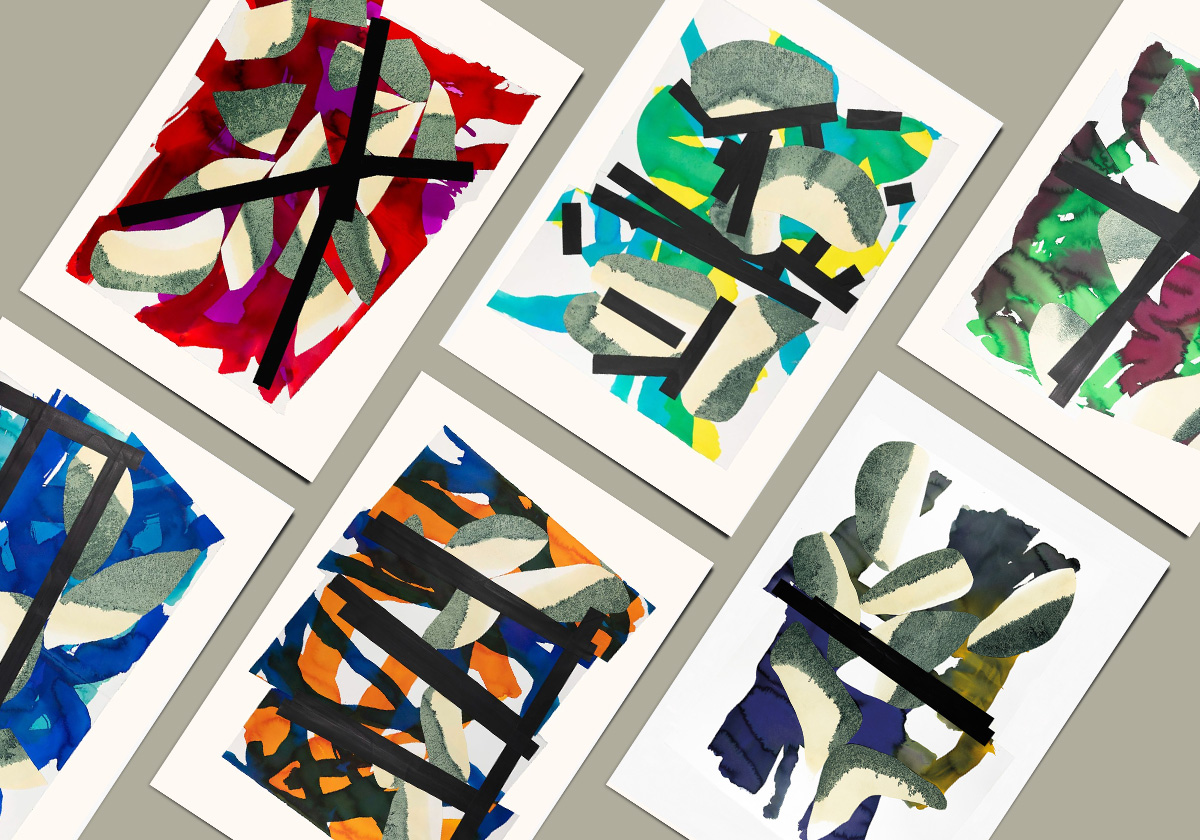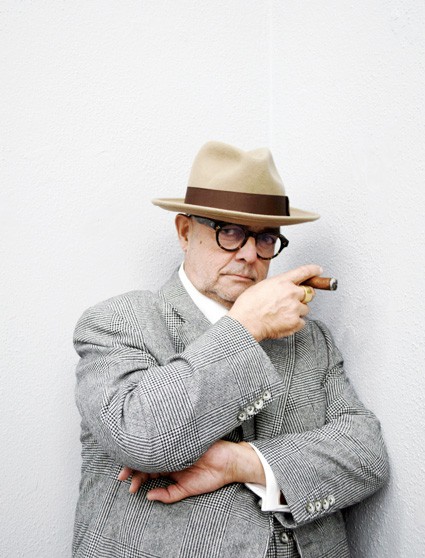
Pedro Cabrita Reis
Interview
Pedro Cabrita Reis is an unavoidable name in contemporary art. Overcoming borders, his works, and their foundation, are already history. Exclusively for screen-printing, the artist developed a set of six projects, which define the series "Cactus Flowers". At the artist's suggestion, he was interviewed by Rafael Prates, which resulted in a good and clarifying conversation in his studio.
Today is November 20, 2023, and this registration is from a conversation in my studio by 6 pm, almost 7 pm, with Rafael Prates, in the context of a screen printing project that I am doing for CPS. This conversation is intended to be part of a publication [Revista arte #38] around these screen prints, to be produced by Centro Português de Serigrafia (Portuguese Screenprint Center). Hello Rafael, good afternoon. Let's go then.
Let's go! Pedro, you have always had a very diverse work. From sculptures with a very industrial character that you have exhibited in museums all over the world, to the cacti that you present to us here with beautiful flowers. How do you reconcile this heterogeneity?
Throughout my life, I have always done and have always had a multidisciplinary practice, therefore, from painting to drawing, sculpture, etc. In addition to this technical multidisciplinarity, from a thematic or conceptual point of view, I have always, in one way or another, produced works that accompanied each other, being certain that some came from some presumption from nature. They also went through the representation of the portrait and went to other sides like, as you just said, objects of a more industrial, more constructive nature. It was a freedom that I always gave myself. I gave myself the freedom to always do what I wanted. And an artist must have a total openness in relation to the world that surrounds him - and of which he is a part - in order to absorb all the information that he collects through his eyes. One can never imagine, or at least I don't imagine, that an artist has an exclusive, unidirectional and particular source, which gives focus and form to their art. The artist is alive, he is subjected to a set of suggestions, stimuli, proposals, moments, and transforms this immense variety of moments into his work. Probably some artists choose from this variety of stimuli a very specific set and from there the design what is their creative process: that's legitimate. I use everything, I do everything, I follow everything. And, in fact, in my work there is kind of a portrait of the world. In other words, all my work is an object of reconstruction of the world in all the variants that this world offers me. I paint a tree as quickly as I make a sculpture that is a black cube.
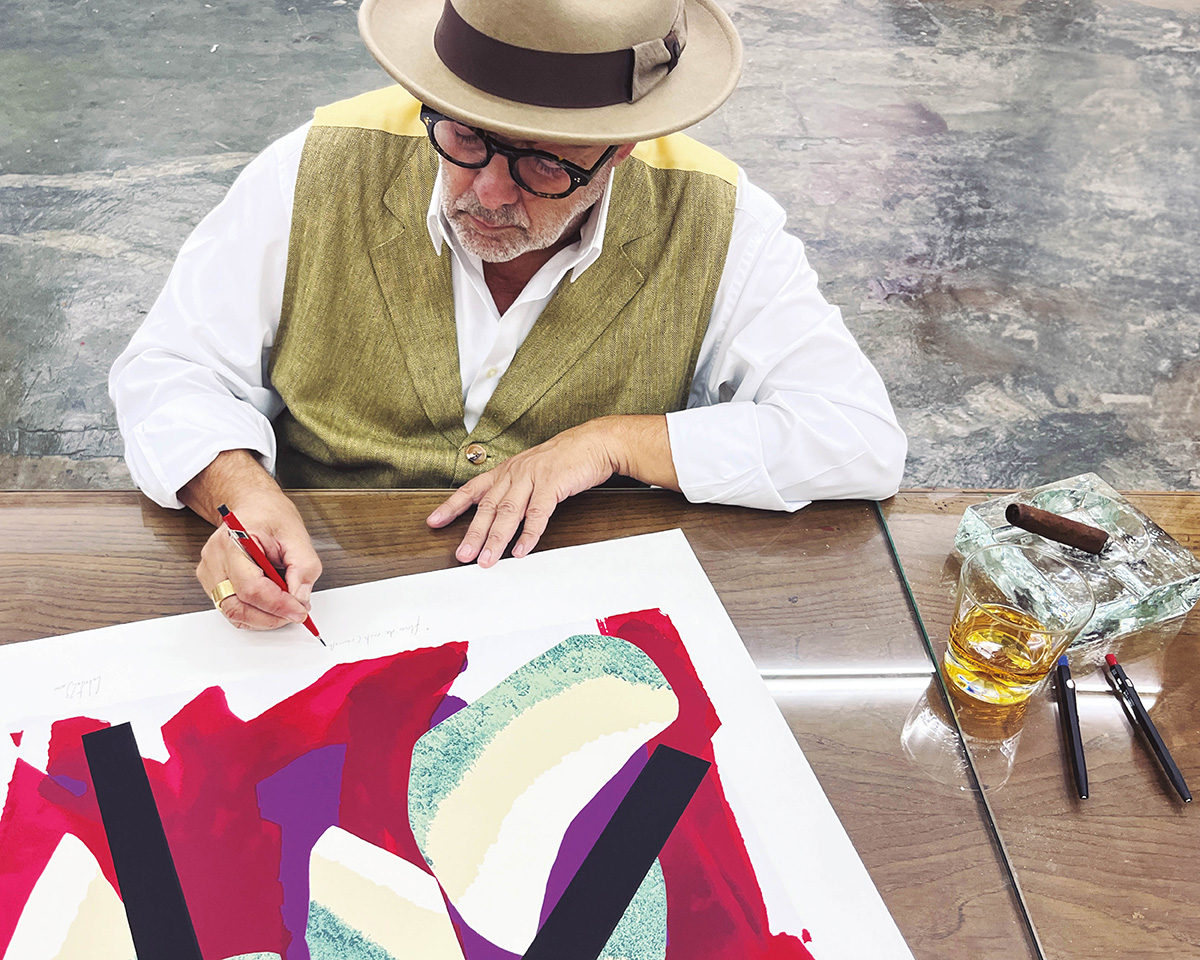
Six distinct screen prints form the series " Cactus Flowers" which marks the artist's editorial debut at CPS.
Despite this interaction of yours with the reality that surrounds you, and especially in comparison with human and constructed reality, your relationship with Nature is something more particular.
I must tell you that on the one hand, there are several statements of mine in programmatic terms, expressed in texts, in interviews, in media articles, where I said that nature was not part of my concerns. And at the same time, and apparently in contradiction to this, yes, all my life I have made representations, interpretations, variations, modifications, reconstructions of what would be a hypothetical relationship between me and nature. It is curious this contradiction that is constructed from statements of a, let's say, programmatic nature. Words that later, in practice, end up being the object of a confrontation with another practice, which is the practice of artistic creation. I have always painted flowers, trees, forests, landscapes, etc. One might ask: Well, then is nature important or not important? Do you make works that draw on nature while rejecting your connection to nature?
I would say that the explanation, if there are any explanations, or the motivation for this apparent contradiction, is not at all complex. One thing is the statement that nature is not important as a moment or as a trigger for an artistic practice. This does not invalidate, and even in some way complements, that the entire nature that I represent in my drawings, in my paintings, in my sculptures, is a nature that comes only and exclusively from thought. It is not a nature that is imbued with formal or physical narrativity. Therefore, I can say, on the one hand, that nature does not interest me as a concept or as a philosophical starting point. And, in the same sentence, I can say: nature, or what we observe in it, interests me as a plastic motif, knowing that everything that interests me as a plastic motif and that gives rise to my works in the most diverse disciplines, is a nature that is, I don't even know if I could tell you, abstract. It is a nature that only exists in my thoughts. Of course, we all have memories. We all start from images of the known. We all look at the landscapes, at the sea, at the trees, at the mountains, and we all extract a source of action from there. A spring of creativity, if you will. Now this source of creativity that reaches the works I make is in no way directly relatable, just by induction, with what I see. In other words, I am not part of any Barbizon School, which is the school that leads, let's say, to the practice of impressionism. For me, the nature that I represent in my paintings is a nature that exists solely and exclusively in my thoughts. Everything that this nature of my thinking may have of the so-called “natural nature”, that is, that which we know from our visual, optical and behavioral experience, are just symptoms, signs, and then everything is transformed through my creative thinking, as an artist, in something totally different. Therefore, I can, on the one hand, say that nature does not interest me and I can, on the other hand, create a nature that interests me.
And in this series of signs that you received, which ones do you consider could have had a more important catalytic role in the creation of these “Cactus Flowers” for us and for our members?
I share my time between Lisbon and my other studio, my other house, which I have in the countryside, in the Algarve, in the mountains, in Tavira. In this place, one of the things that fascinates me most is planting trees, planting cacti, etc. In other words, I have this aspect of my life, which is very important to me. I have a very strong connection to the earth and nature in the sense of a constructed nature. I make gardens, I plant vineyards, I plant oranges, figs, etc. This trajectory of mine, this part of my life, is, like others, a spring of creative energy. I don't have a flower garden at my house. I have a garden made up entirely of cacti. Cacti which, of course, like all cacti, bear flowers. But I don't have a flower garden, as people might imagine at first glance. I really like cacti. I like the resilience of the cactus. A plant that resists. A plant that supports difficulties of all kinds. Which remains. It has a resistance force that continues despite harsh conditions. The cactus is, in some way, if you like, even poetically considered, a very beautiful, full and profound representation of what the human presence in nature is. Resist, continue, adapt, live off what little there is and still persist. Cacti interest me and are present in my work. And when the Portuguese Screen Printing Center, represented by the brothers António and João Prates, invited me to make this series of six screen prints, I went back to what I like. I thought that the most interesting thing for us to start a good working relationship, which I hope will develop in the future, was to start with a base that was dear to me, that interested me. And what was this base? It was about reworking the topic of the cactus as an important identity figure for me. From then on, even making these cactus flowers was, in short, a very brief moment, it was an enlightenment. And I decided that the most interesting thing was to develop my fascination with cacti over these six silkscreen originals. This series “Cacti Flowers” originated from there.
Series which you adorned with colours of a hegemonic presence, even marking its presence in the title of each of the works. How important are these colours here?
Rafael, I, in generic but at the same time absolute terms, am an artist. I am not a sculptor, nor a painter, nor a designer, I am an artist. And what is an artist, beyond everything that people know an artist to be? In my case, I understand myself as an artist in the sense that I am someone who has no disciplinary or technical limitations. In fact, I do whatever I want and the way I want and I wouldn't do it any other way. And yet, being like this, open and free, I have the responsibility to absorb all forms, all practices and all ways of doing. As a painter, what determines an exercise in a painting, regardless of the theme, motivation or design, the narrativity of the painting, its ethical or other objectives, is the exercise around colour. Colour is, ultimately, what painting actually is. And colour can be used and should be used to build in the painting, on the canvas or wherever you want, your program of intentions in relation to what motivates you to make that painting. But colour is always decisive. It is from the domain of colour that you can imagine making a portrait, making a painting, making a landscape, doing whatever you want, a still life... Or even, why not, an abstract, minimalist painting, or any other painting. Screen printing is a technique and a discipline that requires a certain mental and creative device, which includes, taking into account the nature and object of screen printing, the use of colour in a way that is, as I would say, clear, strong and propositional. Screen printing, as we know, is a technique in which the application of colours in successive layers is done in a flat manner. Screen printing does not allow, due to its technical principles, the existence of chromatic nuances. I mean, even if it does allow it, they are always, in some way, small arrangements, let's say, of technique, which in my opinion do not validate what is the original and strong quality of screen printing. Screen printing, in my personal case, lives, above all, from a bright, flat and clear construction of areas of colour, in the sense of transforming the screen-printed object into an object that can be the symptom of concerns in relation to what is being done. A watercolour has other ways of being done. Watercolour allows you nuances, transparencies and all that. Oil is something else. Screen printing is clearly a language of immediacy, clarity and strength of colour. Therefore, the screen prints I made for Centro Português de Serigrafia had to have this quality.
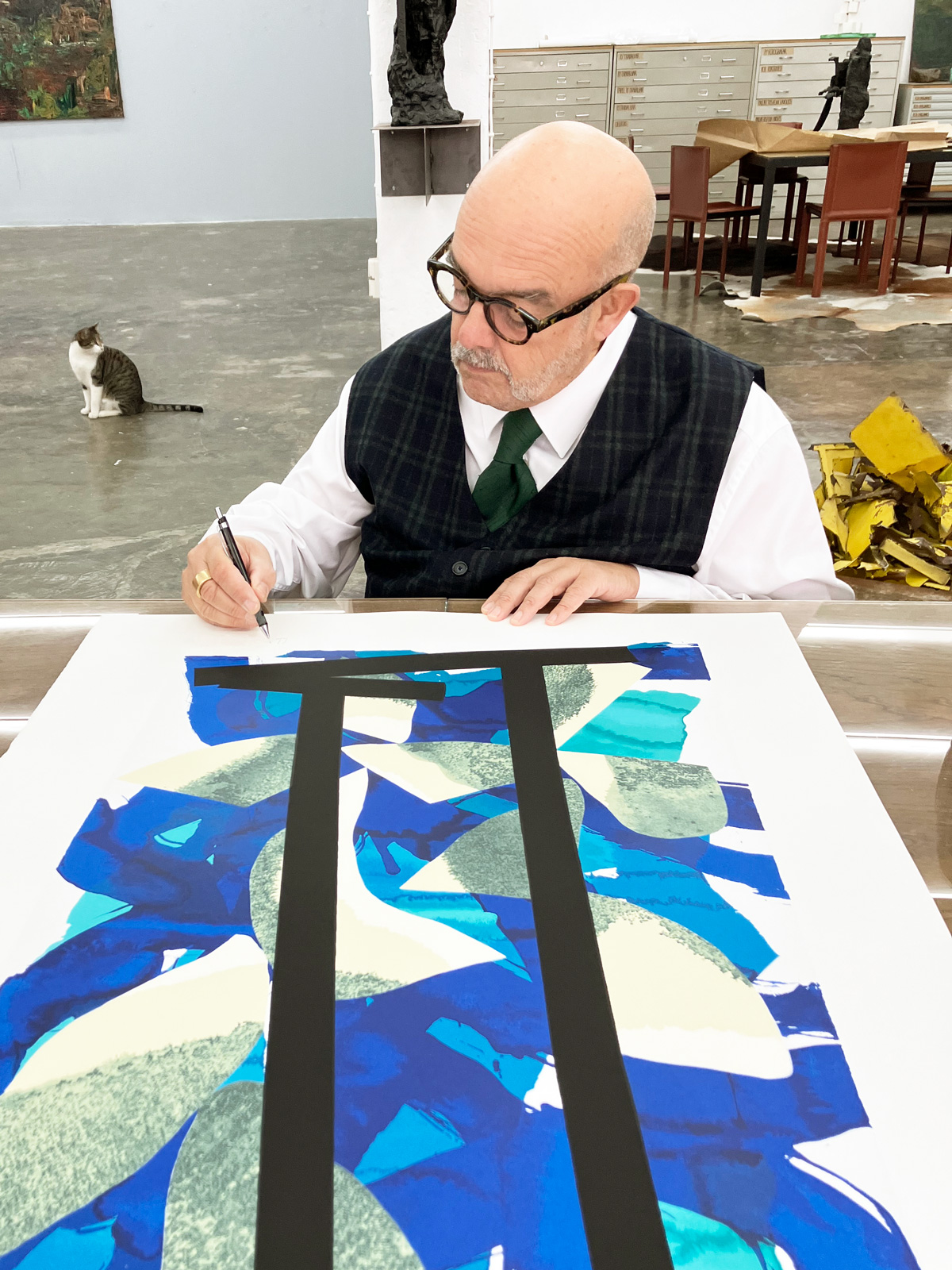
The works are limited to just 74 numbered and signed copies. Artist's studio, nov. 2023.
But despite the strength of these colours that feature in the screenprints, they are almost "cut" by black lines that divide the plane of the work. What are these lines due to?
These lines, in fact, play an essential role in the composition. They are not merely decorative or accidental. However, concurrently, they can have a variety of meanings or interpretations attributed to them.
They can be a deliberate contrast to the vibrant colours that dominate the composition. This contrast represents, above all, a visual metaphor on many levels. It could be, for example, the tension between nature and human intervention. The black of the ribbons symbolizes the presence of the human, its ability to order, structure, and overcome the force of nature. In contrast, the bright colours represent the spontaneous, almost indomitable spirit of nature.
On the other hand, these black lines can also represent the movement and vitality of plants, especially cacti. They capture the essence of their growth, which, despite often being imperceptible, is constant and dynamic. It is a way of expressing the living and constantly changing nature, which, although it may seem static, is always developing and evolving.
However, and regardless of this, the black lines in "Cactus Flowers" are, above all, a fundamental visual element that links the work to my artistic thinking. They represent the limits that the artist imposes on his canvas, the boundaries between thought and expression. However, at the same time, they are an invitation to look beyond these borders, to perceive the work as an integrated whole, where each element, be it a black line or a blob of colour, contributes to a broader and deeper visual narrative.
Given the rigour and even considerable technical complexity of these elements of your artistic expression, how was your personal experience, and with the CPS studio, in transmitting them to screen printing?
The studio from Centro Português de Serigrafia is a place lost in time, but it is very good because of that. In other words, there is a group of people who like what they do, who know what they do and, above all, have a very particular enthusiasm for responding to the demands of the artists who work with CPS. In my particular case, my experience is absolutely positive and exciting. I liked it a lot. I really enjoyed it because I hadn't done screen printing since I was at the School of Fine Arts. Many, many years have passed. I'm already of a certain age, I was at the School of Fine Arts many years ago, in the past century, and I have never done screen printing since then. This invitation from Centro Português de Serigrafia was, in some way, exciting for me in the sense that it allowed me to return to work in a discipline and an area that I hadn't for a long time and gave me a great opening to do other things.
Click on the image to see the complete series
In the end, screen printing ends up being just one element of the original graphic work that we carry out at CPS. How do you relate to the multiple of art in general?
The first thing that needs to be said here is that I think the art multiple is important. There are artists who, eventually, do not give it much importance in their careers. It's legitimate, fair enough. I have a different perspective. I really like the multiple, because it allows you to create a work that has a different dissemination among the wider public and that allows you to reach many people. A work that comes with the artist’s charisma, presence and perspective. It is true that, as a multiple, it can be placed on the market at affordable prices for people who, although they are art lovers, still do not have the possibility to access original works. But, however, the creation of a multiple, be it screen printing, engraving, sculpture, through sculpture editions, etc., somehow expands the territory of the relationship between the artist and his audience. It is important that we continue to believe that multiples are fundamental for the construction of an audience, for the education of a taste and for, not only, the expansion of the image of that artist, but also for the consolidation among the public of a practice of accessing works made by artists that somehow have a quality that transforms the product into an object of interest, if you want.
Yes, because in reality, due to the level of distinction that you have achieved, both nationally and internationally, your original works are not easily accessible to the general public.
There is something called the art market. This art market is a complex and constantly changing process. And it is, let's say, a territory affected by a whirlwind of circumstances, ideas and facts. We will never know how to properly classify it. It's always something that creates some perplexity and gives us news that we weren't expecting. This is how it is. Art is, in fact, a product like any other, subject to the laws of the market and which lives and develops as a product within these market laws. These laws often create an irreversible gap between people who like art and the artist's works that are on the market. Producing multiples is important. In fact, there is an ancient history of the production of multiples. In the 17th, 18th centuries, and so on, there was a well-established and recognized practice of engravers who, based on paintings by masters of the time, made reproductions in drypoint engraving, of which many were sold. In other words, Tintoretto made a painting, Titian made a painting, Da Vinci made a painting, Raphael and so on, Caravaggio... And there was a legion of engravers, often even engravers of the artists themselves, to whom they confidently handed over their originals painted on canvas, which were bought on the market by the Church, by the aristocracy, for the kings, or by the purchasing bourgeoisie. But these works were still reproduced in engravings, engravings that were then disseminated at affordable prices on the market. This was delightful. Today, this process is not over. There is no longer this rule of reproducing original works of art using mechanical reproduction methods, such as engraving, screen printing or others. But what happens is that artists create specific works to be reproduced by these mechanical production processes.
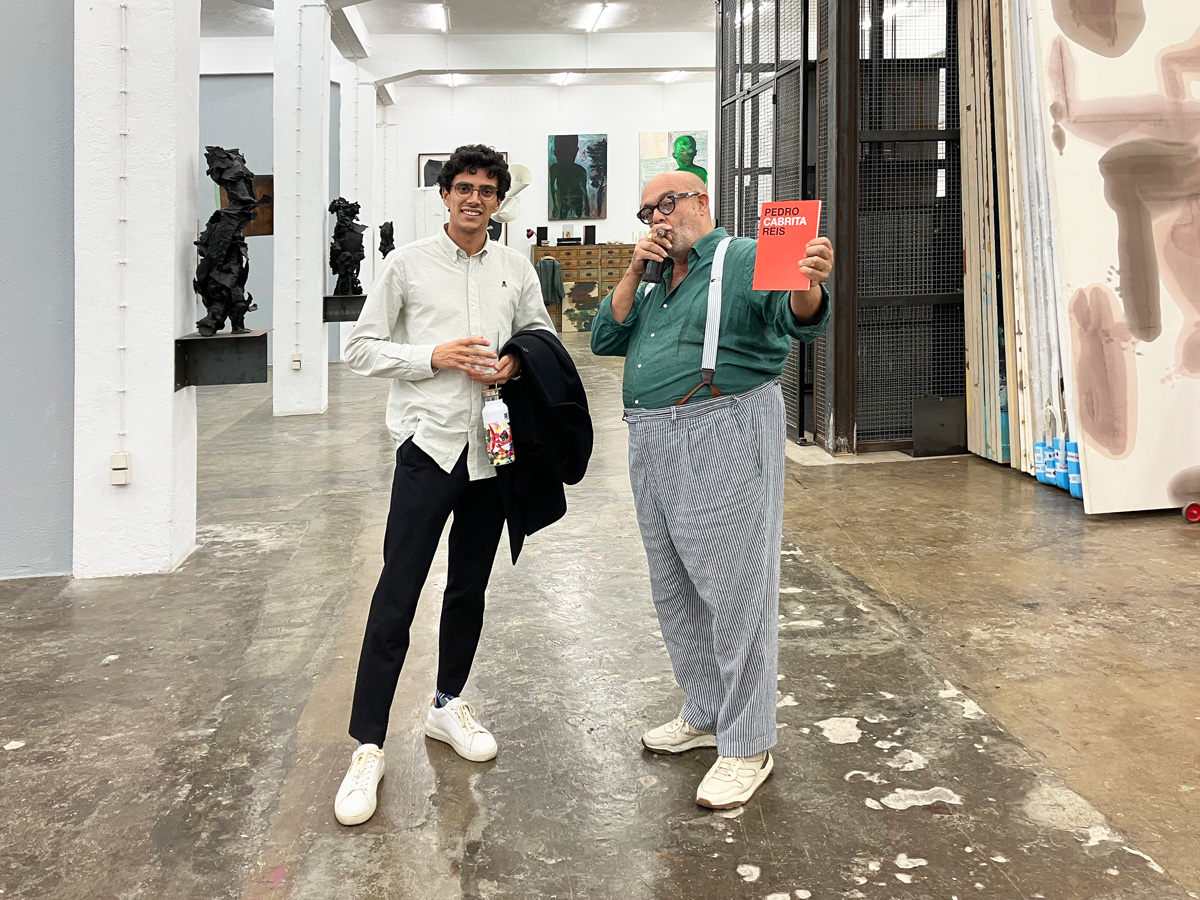
Rafael Prates and Pedro Cabrita Reis. Artist's studio, nov. 2023
The history of the art multiple is, without a doubt, quite interesting and highlights its importance. As you have this interest, you intend, as you have already mentioned, to continue exploring it in future projects with CPS. Maybe even now shifting the spotlight to engraving.
Classical engraving, understood as a methodology and a classical discipline: Yes, definitely yes. Engraving on copper or plate. I really hope that the relationship that I have just started with Centro Português de Serigrafia is as auspicious as I hope and that it can expand to other territories of technical disciplines. And that on one of these days, you'll see me calmly in the engraving studio at CPS making some originals on copper.
And inside Pedro Cabrita Reis' head? Are there any ideas coming up for this next project?
In my head, everything is being born at the same time and without interruption. At any time or moment that my reunion with Centro Português de Serigrafia materialises itself, now in the engraving studio, I will certainly have immense pleasure in making, in producing, engravings that at the time occur to me as a testimony of my pleasure to be doing them.
Photography: Martim Cruz
